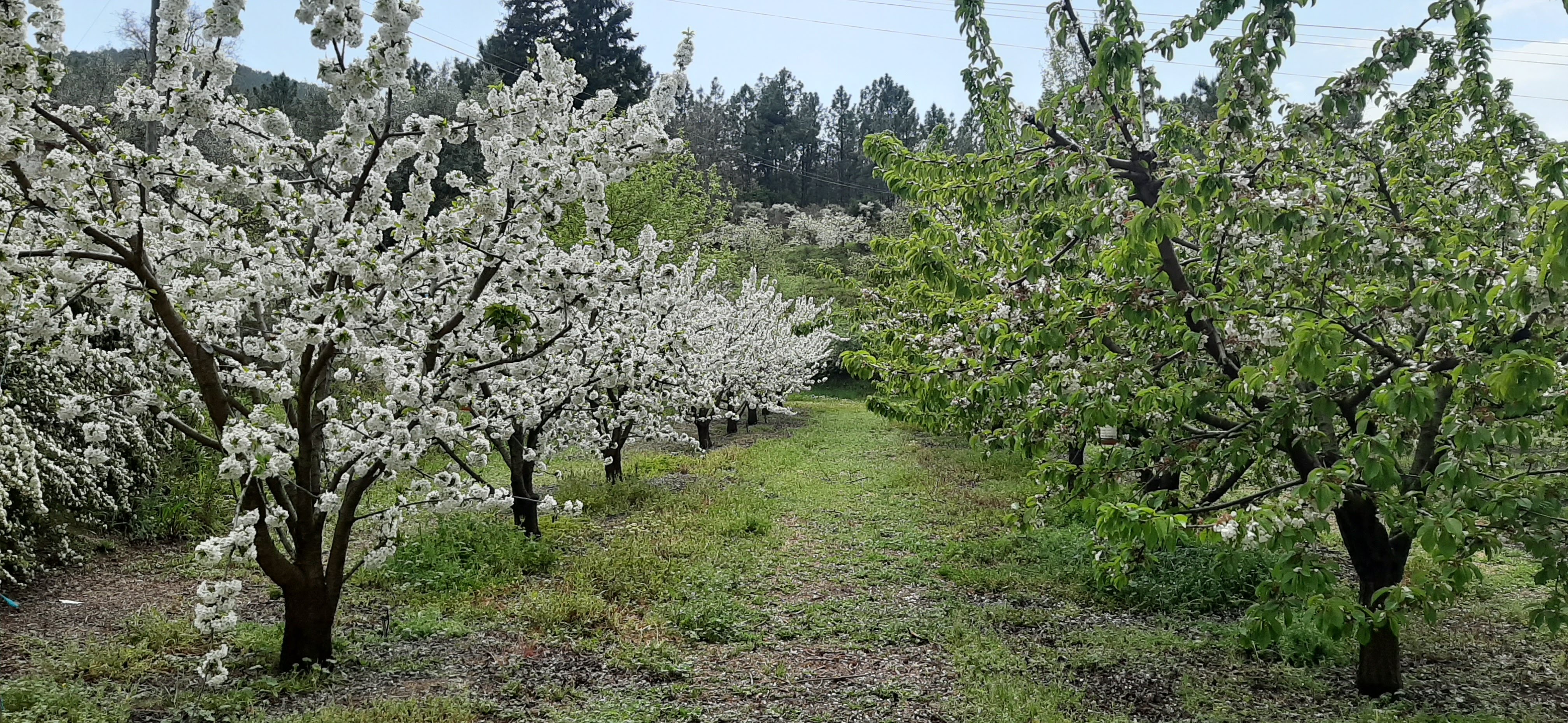Cálcio e algas: fatores determinantes no incremento da qualidade da cereja ‘van’ - Bibliografia
O crescente interesse na produção de cereja tem estimulado a investigação sobre o potencial de aplicações suplementares de cálcio (Ca) e de bioestimulantes à base de algas como forma de mitigar o risco de fenómenos meteorológicos extremos, aumentar a qualidade do fruto e prolongar a sua vida útil pós-colheita. Assim, neste estudo avaliou-se o efeito da aplicação foliar de Ca e de um bioestimulante à base de algas (Ascophyllum nodosum) na produção e qualidade da cereja. O ensaio experimental foi instalado em 2019 num pomar de cerejeiras da cultivar Van, localizado na freguesia de Paus, Resende. Foram realizados cinco tratamentos: FORALG BMo (75 e 150 mL/hL, Bio75 e Bio150), Kiplant Ca (150 e 300 g/hL, Ca150 e Ca300) e controlo positivo (concentrações mais elevadas de ambos os produtos), aplicados no estado fenológico J (fruto em desenvolvimento).

BIBLIOGRAFIA
Aires, A., Carvalho, R., Rosa, E., & Saavedra, M. (2013). Phytochemical characterization and antioxidant properties of baby-leaf watercress produced under organic production system. CyTA - Journal of Food, 11(4), 343–351. https://doi.org/10.1080/19476337.2013.769025
Battacharyya, D., Babgohari, M.Z., Rathor, P., & Prithiviraj, B. (2015). Seaweed extracts as biostimulants in horticulture. Scientia Horticulturae, 196, 39–48. https://doi.org/10.1016/j.scienta.2015.09.012
Brand-Williams, W., Cuvelier, M., & Berset, C. (1995). Use of a free radical method to evaluate antioxidant activity. LWT - Food Science and Technology, 28, 26–30.
Christensen, J.V. (1996). Rain‐induced cracking of sweet cherries: its causes and prevention, in Cherries: Crop Physiology, Production and Uses, ed. by Webster, A.D. & Looney, N.E. CAB International, UK, pp. 297– 327.
Correia, S., Schouten, R., Silva, A.P., & Gonçalves, B. (2017). Factors affecting quality and health promoting compounds during growth and postharvest life of sweet cherry (Prunus avium L.). Frontiers in Plant Science, 8, 2166. https://doi.org/10.3389/fpls.2017.02166
Correia, S., Schouten, R., Silva, A. P., & Gonçalves, B. (2018). Sweet cherry fruit cracking mechanisms and prevention strategies: A review. Scientia Horticulturae, 240, 369–377. https://doi.org/10.1016/j.scienta.2018.06.042
Correia, S., Queirós, F., Ribeiro, C., Vilela, V., Aires, A., Barros, A., Schouten, R., Silva, A.P., & Gonçalves, B. (2019). Effects of calcium and growth regulators on sweet cherry (Prunus avium L.) quality and sensory attributes at harvest. Scientia Horticulturae, 248, 231–240, https://doi.org/10.1016/j.scienta.2019.01.024.
Demarty, M., Morvan, C., & Thellier, M. (2006). Calcium and cell wall. Plant, Cell & Environment. 7. 441–448. https://doi.org/10.1111/j.1365-3040.1984.tb01434.x
Dewanto, V., Wu, X., Adom, K., & Liu, R. (2002). Thermal processing enhances the nutritional value of tomatoes by increasing total antioxidant activity. Journal of Agricultural and Food Chemistry, 50, 3010–3014. https://doi.org/10.1021/jf0115589
du Jardin, P. (2015). Plant biostimulants: Definition, concept, main categories and regulation. Scientia Horticulturae, 196, 3–14. https://doi.org/10.1016/j.scienta.2015.09.021
Erogul, D. (2014). Effect of preharvest calcium treatments on sweet cherry fruit quality. Notulae Botanicae Horti Agrobotanici Cluj-Napoca, 42(1), 150–153. https://doi.org/10.15835/nbha4219369
Gonçalves, B., Landbo, A.K., Let, M., Silva, A.P., Rosa, E., & Meyer, A.S. (2004). Storage affects the phenolic profiles and antioxidant activities of cherries (Prunus avium L.) on human low-density lipoproteins. Journal of the Science of Food and Agriculture, 84(9), 1013–1020. https://doi.org/10.1002/jsfa.1752
Gonçalves, B., Moutinho-Pereira, J., Santos, A., Silva, A., Bacelar, E., Correia, C., & Rosa, E. (2006). Scion-rootstock interaction affects the physiology and fruit quality of sweet cherry. Tree Physiology, 26, 93–104. https://doi.org/10.1093/treephys/26.1.93
Gonçalves, B., Morais, M. C., Sequeira, A., Ribeiro, C., Guedes, F., Silva, A. P., & Aires, A. (2020). Quality preservation of sweet cherry cv. “Staccato” by using glycine-betaine or Ascophyllum nodosum. Food Chemistry, 322, 7. https://doi.org/10.1016/j.foodchem.2020.126713
Hayaloglu, A., & Demir, N. (2016). Phenolic compounds, volatiles, and sensory characteristics of twelve sweet cherry (Prunus avium L.) cultivars grown in Turkey. Journal of Food Science, 81(1), C7–C18. https://doi.org/10.1111/1750-3841.13175
Houba, V., Lexmond, T., Novozamsky, I., & Van Der Lee, J. (1995). State of the art and future developments in soil analysis for bioavailability assessment. Science of the Total Environment, 178, 21–28. https://doi.org/10.1016/0048-9697(95)04793-X
ISO 13299 (2016). Sensory analysis — Methodology — General guidance for establishing a sensory profile
Khan, W., Rayirath, U.P., Subramanian, S., Jithesh, M.N., Rayorath, P., Hodges, D.M., Critchley, A.T., Craigie, J.S., Norrie, J., & Prithiviraj, B. (2009). Seaweed extracts as biostimulants of plant growth and development. Journal of Plant Growth Regulation, 28(4), 386–399. https://doi.org/10.1007/s00344-009-9103-x
Lang, G. (2000). Precocious, dwarfing, and productive - How will new cherry rootstocks impact the sweet cherry industry? HortTechnology, 10(4), 719–725. https://doi.org/10.21273/horttech.10.4.719
Singleton, V., & Rossi, J. (1965). Colorimetry of total phenolics with phosphomolybdic-phosphotungstic acid reagents. American Journal of Enology and Viticulture, 16, 144–158.
Shukla, P.S., Shotton, K., Norman, E., Neily, W., Critchley, A.T., & Prithiviraj, B. (2018). Seaweed extract improve drought tolerance of soybean by regulating stress-response genes. AoB PLANTS, 10(1), 1–8. https://doi.org/10.1093/aobpla/plx051
Winkler, A., Fiedler, B., & Knoche, M. (2020). Calcium physiology of sweet cherry fruits. Trees - Structure and Function, 34(5), 1157–1167. https://doi.org/10.1007/s00468-020-01986-9
Winkler, A., & Knoche, M. (2019). Calcium and the physiology of sweet cherries: A review. Scientia Horticulturae, 245, 107–115. https://doi.org/10.1016/j.scienta.2018.10.012